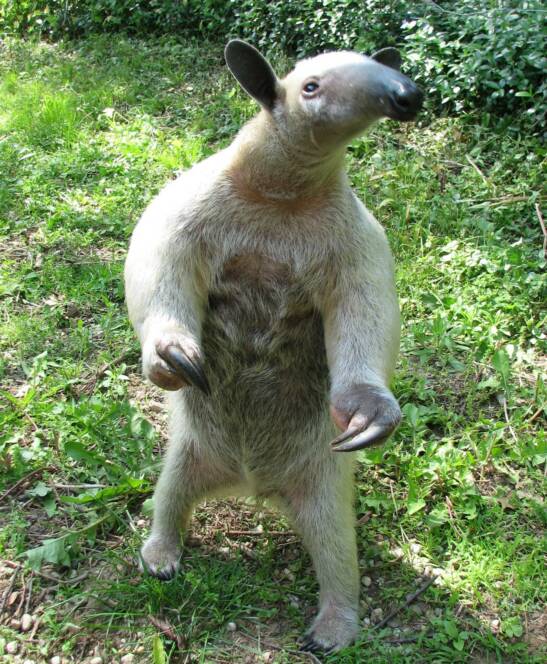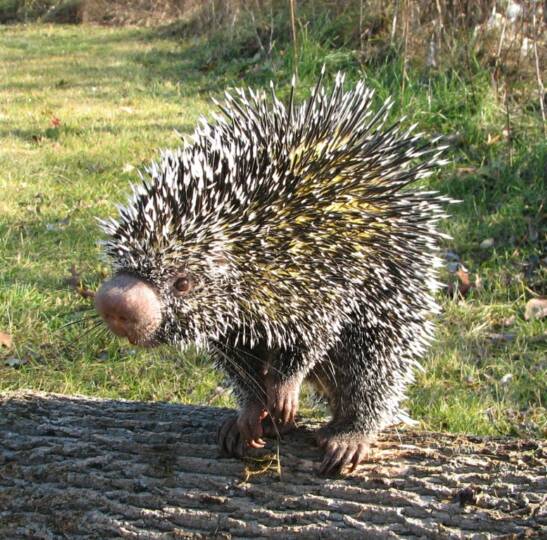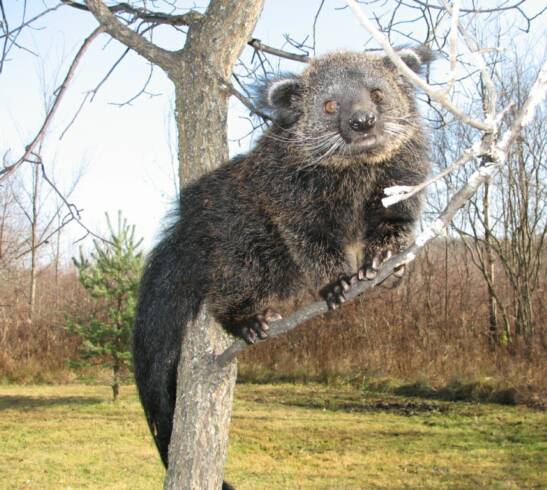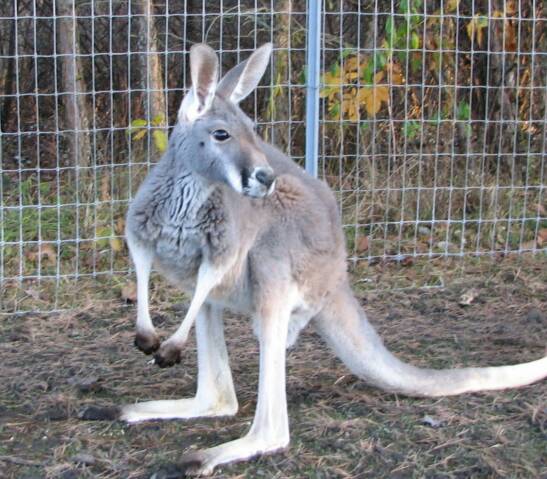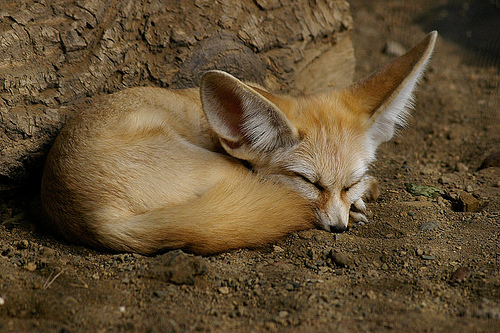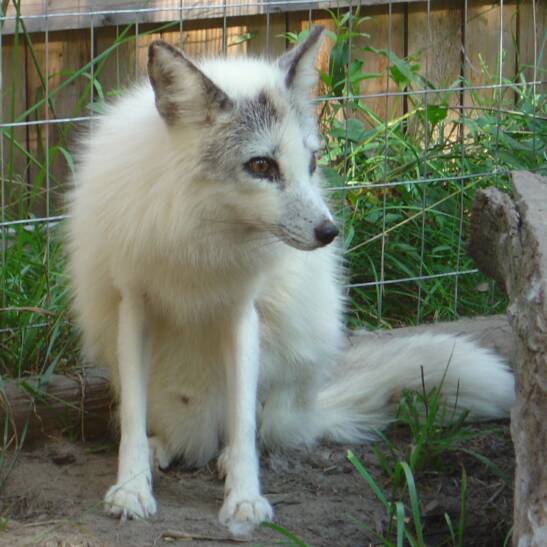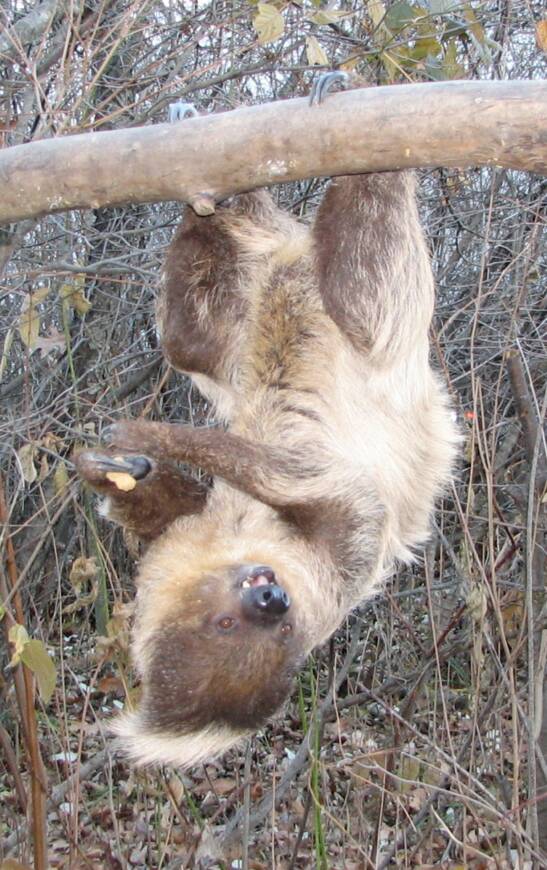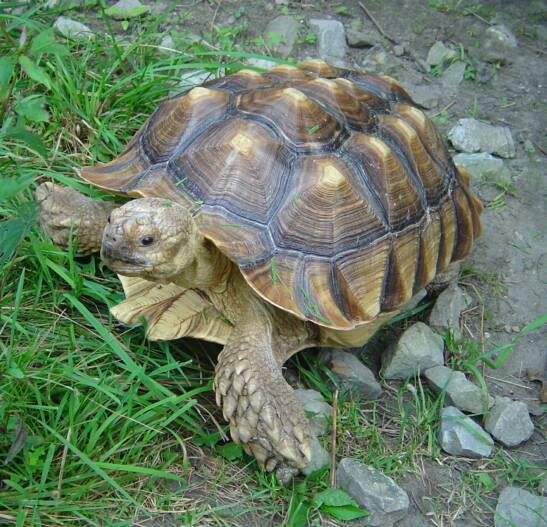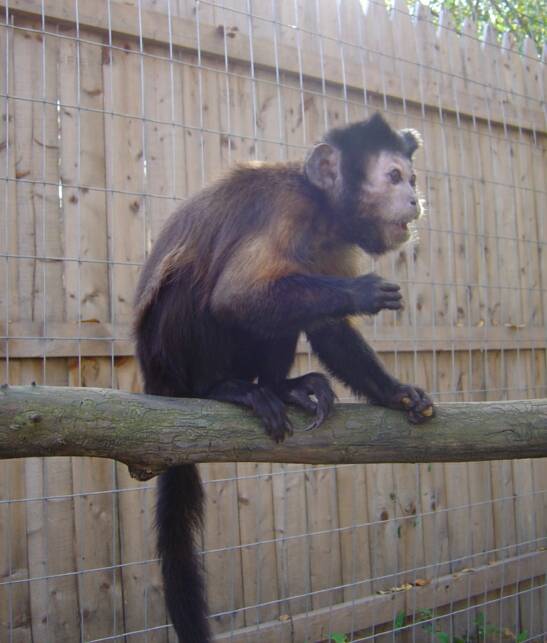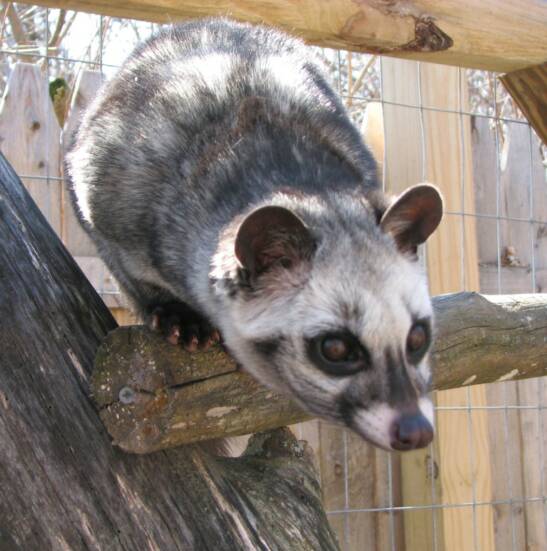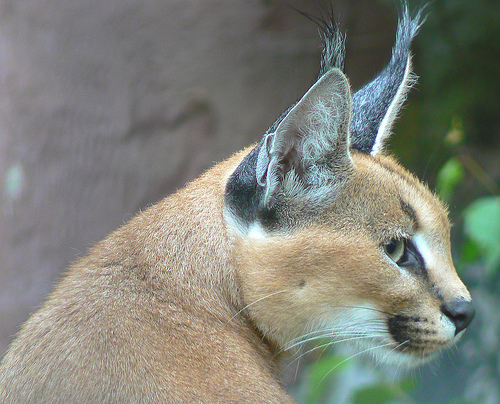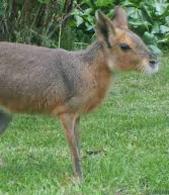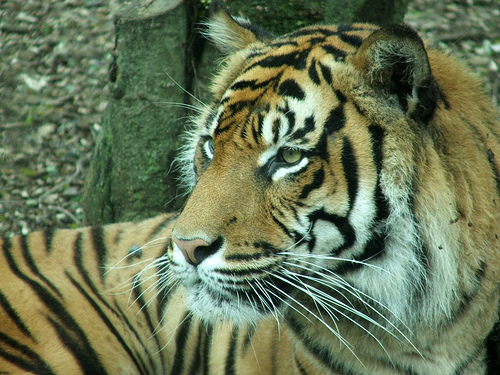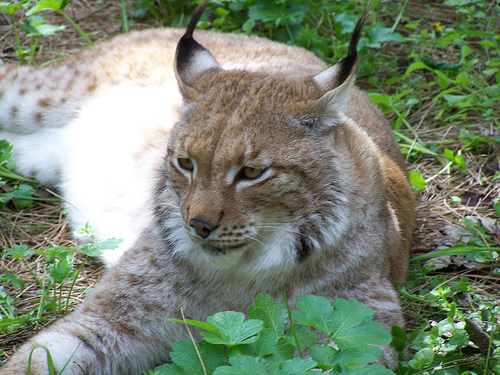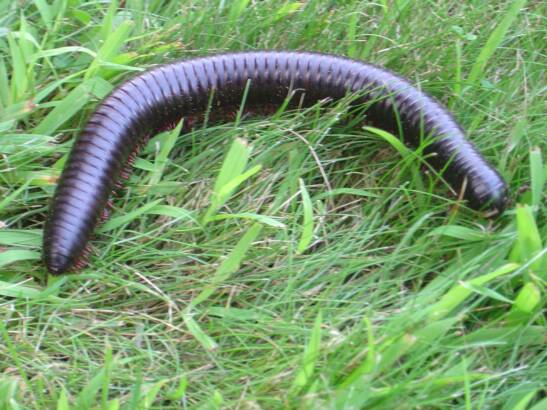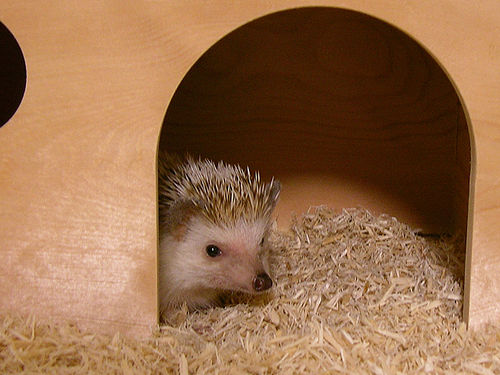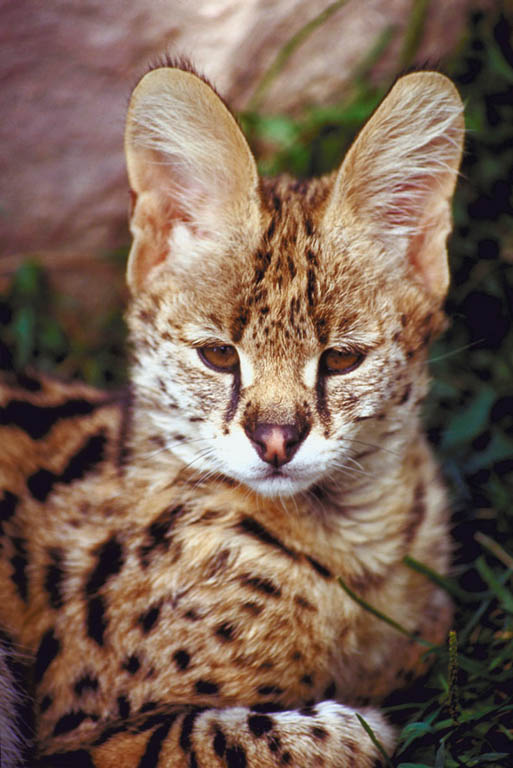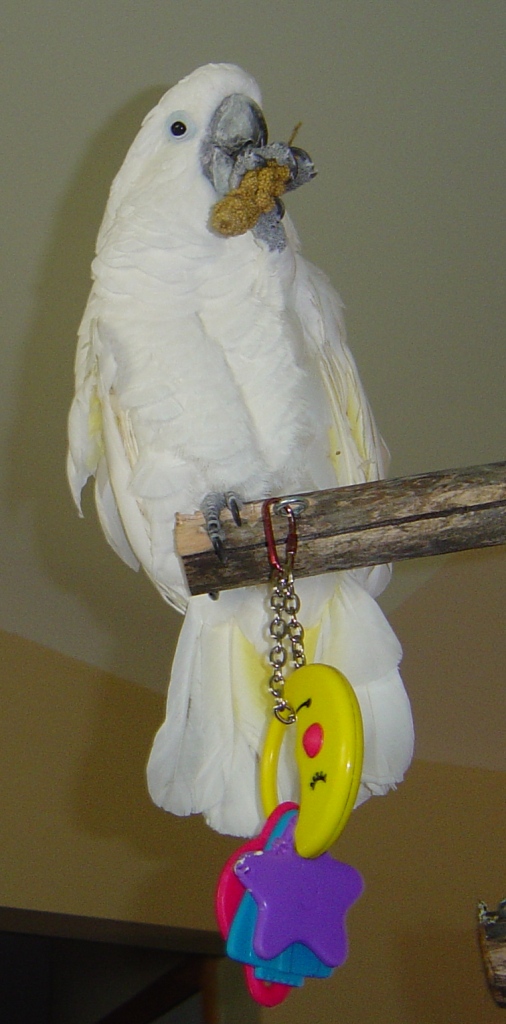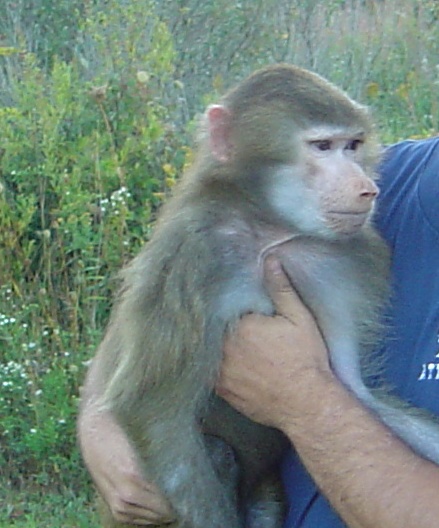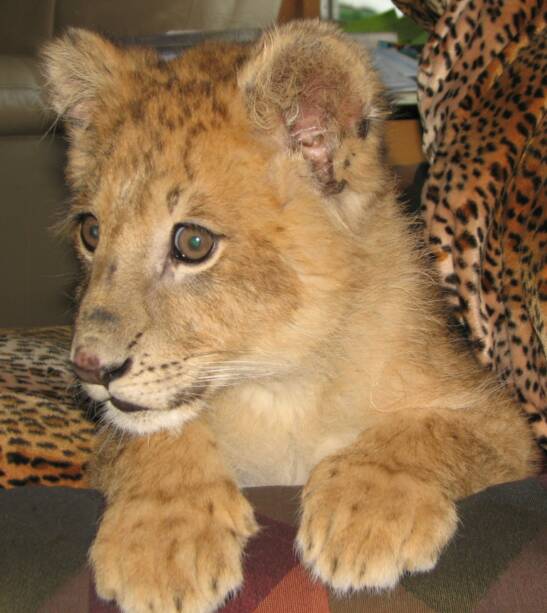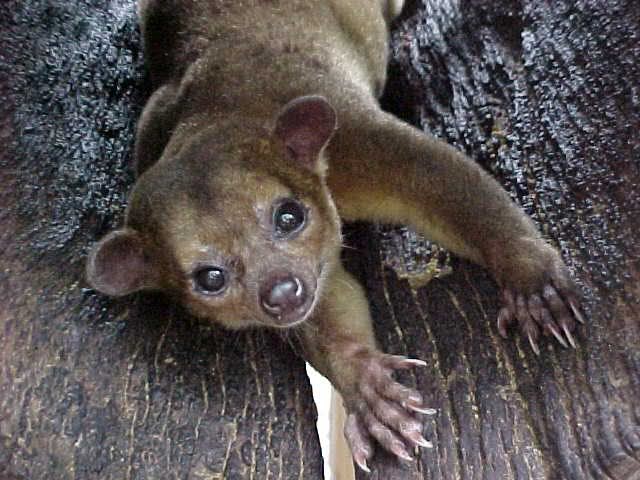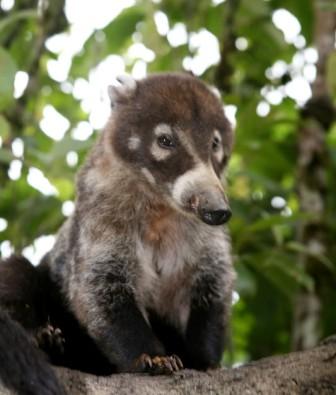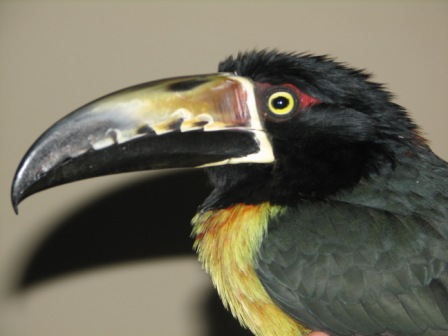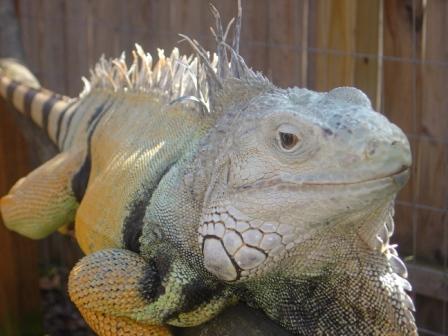Animals At Our Facility...
Tamandua Anteater
Order: Xenarthra
Family: Myrmecophagidae
Distribution: South America
Habitat: Savanna and on the edge of woodlands, also found on cultivated land.
Behavior: The Tamandua feeds on ants and termites which it catches with its
long, sticky tongue. Unlike the giant anteater, however, it can climb nimbly up
trees in search of its prey. A distinctive feature is the unpleasant odor it emits
when in danger, and the posture it assumes to scare away its enemies; it stands
upright on its hind legs with its front legs spread wide in front of it. In spring the female gives birth to a single offspring, and for a long period carries it clinging
to her back or flanks.
Prehensile-tailed Porcupine
Order: Rodentia
Family: Caviidae
Distribution: From Mexico throughout much of South America
Habitat: Tropical Forests
Behavior: This shy, nocturnal porcupine is solitary or else lives in a pair in
the branches of trees, from which it rarely descends to the ground. It shows little fear if it happens to be caught. It is not aggressive but will defend itself
ferociously if attacked. Its diet consists of leaves, fruit, and small fresh twigs
and shoots. As a rule the female gives birth to a single young in the spring.
The newborn porcupine is covered with red hairs and small spines which
harden shortly after birth.
Binturong
Order: Carnivora
Family: Viverridae
Distribution: Burma, Malaysia, Indochina, Sumatra, Java, Borneo, and
Palawan Island.
Habitat: Tropical and subtropical forest
Behavior: With a prehensile tail used as an extra appendage, this "bearcat"
is very well adapted for life amongst the trees. Their diet consists of fruits,
vegetables, plant and animal matter. They are solitary and nocturnal and
are most known for their odor which resembles that of popcorn or
cornchips.
Red Kangaroo
Order: Marsupialia
Family: Macropodidae
Distribution: Throughout inland continental Australia
Habitat: Grasslands, shrub steppe, and salt pans
Behavior: Largest living marsupial, the red kangaroo lives in groups called
"mobs", and is mainly nocturnal, especially in hot weather. Kangaroos can normally jump 4-5 feet high and cover a distance of 12-14 feet per leap. In
short bursts of speed it can attain 35-40 mph but 8 mph is its normal pace.
Kangaroos breed year round, giving birth to a single young, and carrying its young in its pouch for up to 235 days.
Fennec Fox
Order: Canivora
Family: Canidae
Distribution: Africa north of the Sahara, in the Sahara, Arabia, and Sanai Pen
Habitat: Desert, especially in sandy dune areas
Behavior: The Fennec is the smallest breed of fox usually only reaching 3 lbs
full grown. This sociable fox usually lives in small groups of 10-15 amongst
small dens dug in the sand usually consisting of several chambers. Their
diet consists of insects, small vertebrates, and sometimes plants.
Arctic Fox
Order: Carnivora
Family: Canidae
Distribution: Arctic and tundra regions of North America , Eurasia, and
Scandanavia
Habitat: Tundra and ice
Behavior: It lives in burrows and is mostly nocturnal. Pairs remain together
throughout the mating season and perhaps longer. There is a high mortality rate due to harsh climatic conditions. Arctics feed on anything edible including garbage, deer droppings, carrion, rodents, birds, eggs, hares, and even berries.
Two-Toed Sloth
Order: Xenarthra
Family: Megalonychidae
Distribution: Northern South America
Habitat: Tropical forests
Behavior: This tree dweller has strictly a vegetarian diet feeding on foliage. They spend most of their time hanging from branches or resting in the fork between
branches rarely descending to the ground. A sloths fur grows in a way as to allow
moisture to run away from the body. Their fur also allows algae to grow on it,
essentially containing its very own ecosystem, providing food for insects to feed on.
Ring-tailed Lemur
Order: Primates
Family: Lemuridae
Distribution: Southern and southwestern Madagascar
Habitat: Rocky mountains with sparse vegetation
Behavior: Mainly active by day, this lemur lives principally on the ground,
feeding on wild fruits, leaves and flowers. The ring-tailed lemur lives in large
social groups with approximately equal numbers of each sex. Known for being "sun worshipers" these lemurs sun themselves by sitting upright with both arms extended out in a kind of meditative posture.
Sulcata Tortoise
Order: Testudines
Family: Testudinidae
Distribution: Southern edge of Sahara desert in northern Africa
Habitat: Desert
Behavior: The Sulcata tortoise, or otherwise known as the "African Spur Thigh" is the third largest of all the tortoises. It is the largest to be found on a mainland( not an island ). Sulcatas can reach 70-100 lbs. when full grown and have been believed to live 80-100 years old. Their diet consists of any vegetation including cactus.
Capuchin Monkey
Order: Primates
Family: Cebidae
Distribution: Southern Central America
Habitat: Forests
Behavior: It lives in quite large groups, hidden among the dense arboreal vegetation of the forest; it descends to the ground only to drink. They feed on fruit, insects, leaves, small birds, and possibly on small mammals. In order to keep their sense of direction as well as mark territory they leave a scent among
the foliage of the trees by soaking their feet and hands in their urine (urine-
washing).
Palm Civet
Order: Carnivora
Family: Viverridae
Distribution: India, Sri Lanka, southern China, southeast Asia, Philippines, and
the East Indies
Habitat: Forest and woodland
Behavior: This civet is nocturnal and arboreal and is often found in palm trees in villages and towns, but also in many other types of trees. Its name derives
from its liking for palm wine. It feeds on rats and mice (mostly in homes and
cellars), fruit, insects, and small vertebrates. The palm civet often makes its own home in the roofs of houses.
Caracal Lynx
Order: Carnivora
Family: Felidae
Distribution: Africa, Arabia, Middle East as far east as Pakistan
Habitat: Savanna in Africa; desert areas in Asia
Behavior: The caracal is nocturnal, primarily to escape the heat of the day.
Despite its long legs, it does not run that often. However, it does jump very well and often will catch birds in mid-flight. It feeds on many species of mammals and birds, especially rodents and small antelope. It is completely solitary in clearly defined hunting areas.
Patagonian Mara (Cavy)
Order: Rodentia
Family:
Distribution: Central and Southern Argentine
Habitat: Grasslands and brushlands with large open spaces.
Behavior: This is a diurnal creature that usually travels in mated pairs. The male travels behind the female, protecting her from rival males as well as predators.
They may occasionally gather in large groups when vegetation and herbs are plentiful and will spend hours basking in the sun after grazing. Cavies may hop like hares or gallop like horses.
Bengal/Siberian Tiger
Order: Carnivora
Family: Felidae
Distribution: India, Southern China, Siberia, Manchuria
Habitat: Variable, including most forest types
Behavior: The tiger is essentially solitary. It has a clearly staked-out
territory of up to 400 sq. mi., which it patrols at regular intervals, marking it with droppings and other signs. All tigers are highly threatened. As a matter of fact, 3 out of the 7 species of tigers have already become extinct and the remaining 4 are in serious danger.
Depending on species, tigers can range in size from 300-800 lbs.
Siberian Lynx
Order: Carnivora
Family: Felidae
Distribution: Eastern Europe and Asia
Habitat: Forests and woodlands from sea level to high mountains
Behavior: The lynx is active mainly after sundown. It hunts rabbits, hares
birds, and small deer. It usually hunts by ambushing its prey, then leaping swiftly or by stalking its prey then pouncing. Recognized by the tufts of fur on their ears, little is known about the purpose of these "tufts". Some think they exist to identify the same species while others
believe they aid in hearing.
Giant African Millipede
Distribution: Western Africa
Habitat: Tropical and sub-tropical rainforests
Behavior: The giant African millipede is one of the largest growing up to 12 inches in length with a circumference of 2-3 inches. The millipede
has 2 sets of legs per body segment as opposed to its cousin the centipede which only has 1. When threatened, the millipede will curl itself into a tight ball and secrete a foul tasting and smelling fluid to
thwart predators.
Hedgehog
Order: Insectivora
Family: Erinaceidae
Distribution: British Isles, western Europe, Mediterranean islands
Habitat: Deciduous forests, open woodlands, scrub, and sand dunes
Behavior: Hedgehogs build nests of grass and leaves among tree roots or under a bush. It forages from dusk until dawn, sniffing out worms,
insects, snails, and small invertibrates, including snakes. Its eyesight is
poor, however, hearing and smell are excellent. When alarmed it rolls into a tight spiny ball for protection.
African Serval
Order: Carnivora
Family: Felidae
Distribution: Africa, south of the Sahara
Habitat: Open savanna usually near water
Behavior: Servals are mostly nocturnal, and hunt rodents, lizards, and amphibians on the ground, but it can also climb trees where it preys on birds.
The serval also adapts well to living near places inhabited by humans and quickly makes the most of farmyards and poultry runs. Because of this and the
value of their spotted coat, the serval is hunted a great deal and its numbers
are dropping dramatically.
Umbrella Cockatoo
Distribution: New Guinea, Australia, Tasmania
Habitat: Forests bordering water
Behavior: Cockatoos forage in flocks that vary in size from a few dozen birds to
several hundred. Their diet consists of fruits, berries, nuts, and seeds. Cockatoos
posess incredible beak strength capable of breaking through nearly any shell or
mellon hide. They can live upwards of 60 years.
Hamadryas Baboon
Order: Primates
Family: Cercopithecidae
Distribution: Egypt, Ethiopia, Somalia, Saudi Arabia, and Yemen
Habitat: Semi-desert areas, savannas, and rocky areas
Behavior: The Hamadryas baboon was highly regaurded as a sacred animal to the ancient Egyptians so it is called the "sacred baboon". These baboons live in social groups of up to 150-200 individuals, in which there is a strict hierarchical order. When a group is on the move they can travel up to 6 miles
per day. Baboons eat early in the day and at dusk, feeding on plant matter,
small mammals, and birds.
African Lion
Order: Carnivora
Family: Felidae
Distribution: Sub-Saharan Africa
Habitat: Savanna and scrub
Behavior: Lions are social animals, living in prides usually made up of one
or more adult males, 2 or more females, cubs, and adolescents. They hunt mainly at night, but are also active during the cooler period of the day. It hunts by ambushing its prey (zebra and other various hoofstock) and does
not usually pursue it. A lone lioness is usually waiting to take down the prey
with a single blow on the back which ultimately breaks the spinal column.
Kinkajou
Order: Carnivora
Family: Procyonidae
Distribution: Southern Mexico
Habitat: Tropical forests
Behavior: Kinkajous feed primarily on fruits such as wild figs, guavas, mangos, and avacados, but also eat insects and sometimes birds eggs or young birds. Its long tongue enables it to catch insects and to suck the nectar from flowers. They are arboreal, nocturnal, and have a prehensile tail.
Coatimundi
Order: Carnivora
Family: Procyonidae
Distribution: Southwestern United States to Argentina
Habitat: Tropical forests
Behavior: The coati is omnivorous and active by day. Older males are usually solitary, but the females and young sometimes form large wandering groups. Coatimundis have been referred to as the South American Raccoon because of thier similar behavior and characteristics.
African Crested Porcupine
Order: Rodentia
Family: Hystricidae
Distribution: North Africa and central western Africa
Habitat: Dry, rocky hill country, with vegetation
Behavior: The largest of all porcupines, the African Crested can reach a weight of 40 - 60 lbs. when full grown and the quills can be as long as 12 - 16 inches in length. When in danger the porcupine erects its quills on its back and tail and makes them vibrate with a distinctive, rattling sound.
Collared Aracari
Order: Piciformes
Family: Ramphastidae
Distribution: Southern Mexico to Panama, Ecuador, Colombia and Venezuela
Habitat: Lowland forests and slightly more open woodlands
Behavior: The Collared Aracari is one of the most widely distributed of the toucans. They are a social bird, usually traveling and nesting in groups of 6-15 birds. The females usually lay 2-4 small white eggs in an unlined nest which are incubated by both male and female. The Aracari feeds primarily on fruits but has been known to feed on small insects and even other bird eggs. The adults typically reach a size of 41cm long and weighing 230g.
Green Iguana
Order: Squamata
Family: Iguanidae
Distribution: Central and South America from southern Brazil and Paraguay as far north as Mexico and the Caribbean Islands.
Habitat: Forrests often near water
Behavior: The Green Iguana is a large arboreal herbivorous species of lizard which can grow from 4.9 to 6.6 feet in length with bodyweights upward of 20 pounds. Agile climbers, Iguanas can fall up to 50 feet and land unhurt (using their hind leg claws to clasp leaves and branches to break their fall). During cold, wet weather, Iguanas prefer to stay on the ground for greater warmth.
